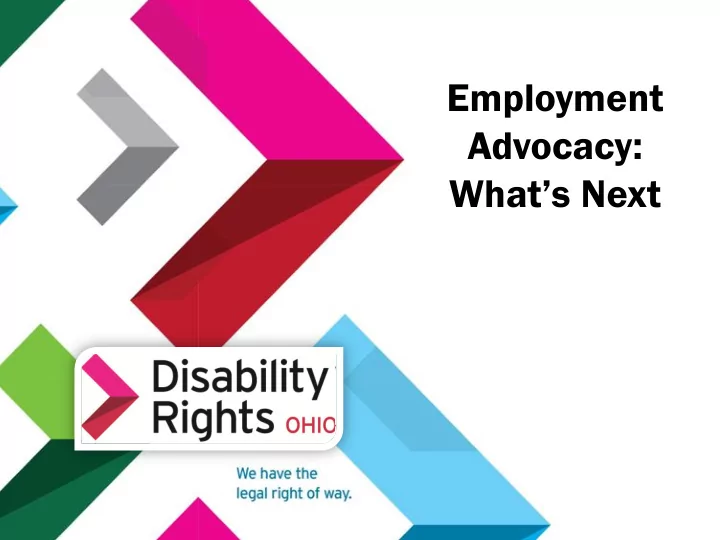

Employment Advocacy: What’s Next
Petition for Review of Wages • Administrative Law Judge • Burden on employer • Time limits for hearing
Criteria for 14(c) wages • Nature and extent of disability of individual employed as this disability relates to productivity • Prevailing wages of experienced employees not disabled for the job who are employed in the vicinity in industry engaged in work comparable to that performed at the special minimum wage rate
Criteria for 14(c) wages • The productivity of the workers with disabilities compared to the norm established for nondisabled workers through the use of a verifiable work measurement method, or the productivity of experienced nondisabled workers employed in the vicinity on comparable work
Nexus Requirement Regulations require: • An individual whose earning or productive capacity is not impaired for the work being performed cannot be employed under a certificate issued pursuant to this part and must be paid at least the applicable minimum wage
Nexus Requirement ALJ construed regulation as requiring: “proof of a clear nexus between the diagnosed impairment and the impact of that impairment on the actual work tasks being performed in order to justify the payment of a special minimum wage.”
Not enough • To have a disability alone • To be less productive on the job
“cause -and- effect” “[I]t would be pure speculation to conclude that the Petitioners don't meet the production standards solely or primarily because of their respective disabilities. It is just as likely they don't meet the production standards because they are bored with a highly repetitive task they have performed on a hundred prior occasions, or because they lack a substantial economic impetus to perform at a higher level, or because they self-identify as individuals whose performance should be lower than their non-disabled supervisors.”
Measuring Productivity ALJ concerns in setting wages: • Lack of accurate documentation • Great variability • Concerns over methodology of workshop consultant because of the wide variances
Measuring Productivity • Follow the DOL field operations handbook • Measure the wage setter and the person with a disability equivalently (i.e. under same circumstances) • For piece rates, in particular, consider time for waiting on supplies or re-setting machines
Remedies • Back pay of minimum wages • Minimum wages now and into the future • Liquidated damages equal to the back pay • Attorneys fees
Status of Case • On appeal before the DOL Administrative Review Board • DOL Wage and Hour Division Administrator supported 95% of ALJ decision with amicus brief • Other amici support included: NDRN, ASAN, and Blind Industries and Services of Maryland
DOL Amicus Support • Nexus requirement for disabled for the work performed • Improper determination of wage rate • Liquidated damages available as a remedy
Unknowns: SOL • DOL amicus raised the question of what statute of limitation should apply • ALJ found that no statute of limitation applied – which DRO argued is consistent with the employer’s burden of proof • 2 years versus 3 years could invoke a need to prove willfulness
Unknowns: Attorney Fees • ALJ awarded petitioners attorney fees and costs • DOL amicus did not support attorney fees as an available remedy in a 14(c) petition
Don’t forget the ADA • Sheltered workshops are employers, and most have 15 or more employees • ADA Title I requires reasonable accommodations for employees with disabilities • Broad coverage • No magic words to request an accommodation
Section 504 • Many sheltered workshops receive federal funding • Section 504 of the Rehabilitation Act has similar requirements as Title I of the ADA requiring reasonable accommodations of employees
Big Picture: Integrated Employment • States have an obligation to operate their employment services system so that individuals can receive the services they need to work in the most integrated setting appropriate
Employment First • Presumption that all persons can work in competitive integrated employment if given supports • A starting point from which to build a system of services to allow individuals to make informed choices
Legal Advocacy • Lane v. Oregon - settled • DOJ consent agreement in Rhode Island • Ball v. Kasich – new class action in Ohio
Ball v. Kasich • People in ICFs spend their days in segregated sheltered workshops or day habilitation programs • Do not have access to the recent Employment First initiatives • Overall, 93% of Ohio’s funding for employment services spent on segregated programs
QU QUESTIO IONS NS?
Recommend
More recommend